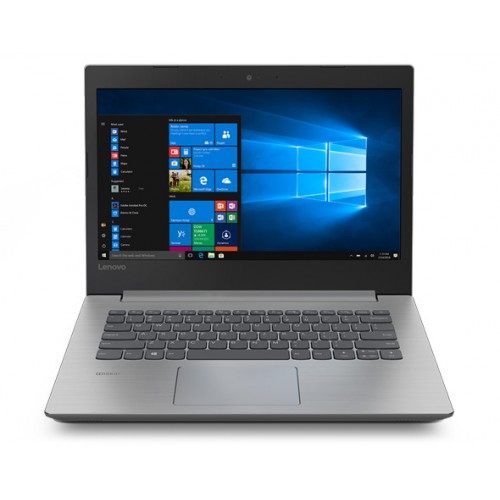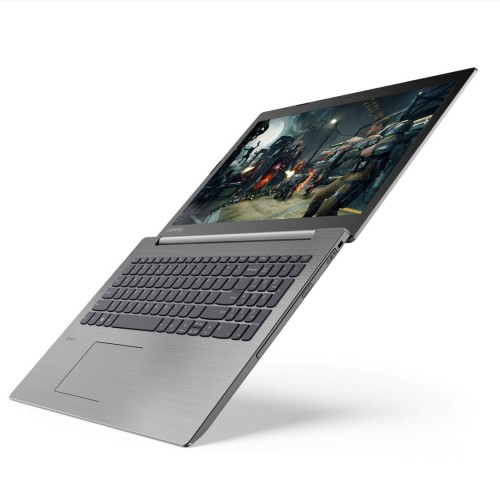Lenovo Ideapad 330 Celeron Dual Core 15.6 inch HD Laptop (Grey)
৳27,450 Original price was: ৳27,450.৳25,800Current price is: ৳25,800.
Quick Overview
- Model: Lenovo IP330
- Intel® Celeron N4000 (1.10 GHz up to 2.60 GHz)
- 4GB DDR4 Ram
- 1TB HDD
- 15.6″ HD (1366 x 768)
Out of stock
Specification
| Basic Information | ||
| Processor | Intel® Celeron® N4000 Processor (4M Cache,1.10 GHz up to 2.60 GHz, 2 Cores, 4 threads) | |
| Display | 15.6” HD (1366 x 768) | |
| Memory | 4 GB onboard DDR4 | |
| Storage | 1 TB SATA HDD | |
| Graphics | Intel® UHD Graphics 600 | |
| Operating System | Free Dos | |
| Battery | Up to 6 hours | |
| Audio | 2 x 1.5 W speakers with Dolby Audio™ | |
| Input Devices | ||
| Keyboard | Standard keyboard | |
| Optical Drive | Yes | |
| WebCam | HD Camera | |
| Card Reader | 4-in-1 card reader (SD, SDHC, SDXC, MMC) | |
| Network & Wireless Connectivity | ||
| Wi-Fi | 1 x 1 AC WiFi | |
| Bluetooth | Bluetooth 4.1 | |
| Ports, Connectors & Slots | ||
| USB (s) | USB Type-C 3.1 2 x USB 3.0 (one charging) |
|
| HDMI | 1 x HDMI | |
| Audio Jack Combo | Audio jack | |
| Physical Specification | ||
| Dimensions (W x D x H) | 378 mm x 260 mm x 22.9 mm / 14.1″ x 10.2″ x 0.9″ | |
| Weight | Starting at 2.2 kg / 4.85 lbs | |
| Color(s) | Grey & Blue | |
| Warranty | ||
| Manufacturing Warranty | 01-year warranty | |
Description
Lenovo Ideapad 330 Celeron Dual Core 15.6 inch HD Laptop (Grey)

Lenovo Ideapad 330 Celeron Dual Core 15.6 inch HD Laptop (Grey). Notebooks are not as flexible as a desktop setup when it comes to upgrading the system. You cannot just change or upgrade a component as you can do with your desktop. When you make your choice, you’ve made it.
For this reason, we recommend you to think carefully about what you will do with your next laptop before you make the purchase. In this guide, we want to take you through the factors and features you need to keep in mind while purchasing a new notebook.

Size
When it comes to notebook, size matters. Based on what you want to be doing with your notebook, you’ll want to make sure you pick the right size that’s the right fit for you. As you cannot change the size later, like you can upgrade the RAM or ROM, it is crucial to pick the right size.
Notebook sizes tend to start at 11.6-inches and go all the way up to 17.3 inches. If portability is what you are looking for, you’ll want to go for a smaller sized notebook. Smaller sized notebooks, however, don’t usually support high-end CPUs or graphics card that comes with their 15.6 counterparts..
Lenovo Ideapad 330 Celeron Dual Core 15.6 inch HD Laptop (Grey)
Screen Resolution
Lenovo Ideapad 330 Celeron Dual Core 15.6 inch HD Laptop (Grey). Along with the size, screen resolution of your next notebook should also be taken into account. You’ll probably end up staring at your screen hours at a time, so it is important to get a screen that is comfortable to look at.

Anyways, next jump into the next thing to take into account while speaking about the display, screen resolution. The minimum screen resolution you’ll usually find is 1366×768 pixels. You should go for a 1920×1080-pixel resolution if you want plenty of space to keep things in view. Some modern notebooks also offer 4K resolution but you have to pay a premium to have such high-spec resolution.
If you are a gamer, you must check the refresh rate, as a faster refresh rate can give you a competitive advantage in online gaming.
Viewing angle is another important factor to take into account. A laptop with an IPS display usually offers the widest viewing angle to suit your needs.
Keyboard
For longer typing sessions, you should opt for a notebook that has a comfortable layout with full-sized keys and some space around the arrow keys. The keys should have adequate travel on the downstroke and snappy responsiveness when you let them go. You need to make sure the keyboard has backlit if you often type in dimly lit environments.
CPU
Intel’s core-based processors are usually anyone’s preferred choice when it comes to buying a new notebook. In terms of multitasking and multimedia tasks, an Intel core processor offers the best performance in general. Entry-level systems come with core-i3 processors, while the majority of the mainstream computers are powered by core i5 processor.
You should opt for core i7-based system if you want the best performance from your notebook. Extremely high-end laptops house core i9 processors but they come with a hefty price tag.
RAM
Unless you are an extremely lightweight user, you should pick a notebook with at least 4 GB of RAM. 8 GB Ram is considered as a perfect choice for productivity users nowadays. 16 GB of RAM is the way to go if you’re a power user. Gamers may opt for 32 GB of RAM to have the desired gaming experience they want.
Lenovo Ideapad 330 Celeron Dual Core 15.6 inch HD Laptop (Grey)
Storage
Lenovo Ideapad 330 Celeron Dual Core 15.6 inch HD Laptop (Grey). Many say the days of hard drives are gone and it is time to embrace SSDs. Slow and bulky HDDs, which generate both heat and noise, are not a good option for thin and light notebooks. SSDs, one the other hand, offer a lot more speed compared to HDDs. These drives also run silently and don’t add much to the weight of a notebook.
But SSDs don’t come with much capacity and these drives are more expensive than traditional HDDs. You will end up with a drive that’s either 128 GB, 256 GB, or 512 GB in size but costs more than a 1 TB or 2 TB HDD.
To find a sweet spot, many laptop manufacturers now pair a smaller SSD with a larger hard drive. This allows users to keep the OS on SSD to have the speed benefit and keep media and other data on the HDD.
Battery Life
The battery life of a notebook depends on many variables, such as screen brightness, screen resolution, number of applications running in the background, plus whether or not you remain connected to Wi-Fi networks or Bluetooth devices. The operating system also plays a major role in terms of determining battery life. That’s why notebook with Chrome OS tend to offer better battery life compared to those with Windows 10.
Connectivity
Due to the limited room around its base, a notebook has far fewer ports than a desktop setup. Some notebooks have as few as two USB ports. In such cases, you may need to unplug one device to plug in another. Larger laptops usually have at least three USB ports, which is fine for most users. Many present-day notebooks have at least one USB 3.0 [USB 3.1 Gen 1] port for faster data transfer, which is ten times faster than USB 2.0. if possible, you should take things a step further and go for a laptop with USB 3.1 Gen 2 ports, as the data transfer rate is as high as 10 Gbps.


















Reviews
There are no reviews yet.